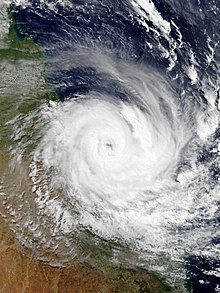 Debbie approaching Queensland shortly after peak intensity on 28 March | |
| Meteorological history | |
|---|---|
| Formed | 23 March 2017 |
| Remnant low | 30 March 2017 |
| Dissipated | 7 April 2017 |
| Category 4 severe tropical cyclone | |
| 10-minute sustained (Aus) | |
| Highest winds | 175 km/h (110 mph) |
| Lowest pressure | 949 hPa (mbar); 28.02 inHg |
| Category 4-equivalent tropical cyclone | |
| 1-minute sustained (SSHWS) | |
| Highest winds | 215 km/h (130 mph) |
| Lowest pressure | 937 hPa (mbar); 27.67 inHg |
| Overall effects | |
| Fatalities | 14 total |
| Damage | $2.73 billion (2017 USD) (Second-costliest tropical cyclone in the Australian region basin) |
| Areas affected | Queensland, New South Wales, New Zealand |
| IBTrACS | |
Part of the 2016–17 Australian region cyclone season | |
Severe Tropical Cyclone Debbie in 2017 was the strongest tropical cyclone to strike Queensland since Marcia in 2015, and was the costliest tropical cyclone in Australia since Yasi in 2011. Forming as a tropical low on 23 March, the low gradually intensified into a named tropical cyclone on 25 March. After steadily strengthening offshore to a Category 4 system, Debbie eventually made landfall near Airlie Beach, at 12:40 AEST on 28 March.[1] Afterwards, Debbie rapidly weakened into a tropical low by late 28 March, but continued to travel south, causing significant damage and flooding in the populous areas of South East Queensland and Northern Rivers.[1] In total, the storm caused A$3.5 billion (US$2.67 billion) in damage and fourteen deaths across Australia, primarily as a result of extreme flooding. This makes Debbie the deadliest cyclone to hit Australia since Fifi in 1991.[2]
- ^ a b Tropical Cyclone Debbie Technical Report (PDF). Bureau of Meteorology (Report). March 2018. Retrieved 25 April 2018.
- ^ Kamenev, Marina (2 February 2011). "Australia's worst cyclones: timeline". Australian Geographic. Retrieved 7 April 2017.